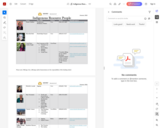
Find speakers to come to your classroom in person or virtually, based on their specialty.
- Subject:
- Indigenous Perspectives
- Material Type:
- GAP 4
- GAP 5
- GAP 6
- Date Added:
- 10/25/2022

Find speakers to come to your classroom in person or virtually, based on their specialty.

The Indigenous Voices and Reconciliation learning channel aims to engage learners in discussions about Canada’s colonial history and its impact on Indigenous communities. Explore our collection of films by distinguished Indigenous filmmakers, creators, and allies.
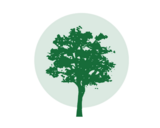
Inspiring Success: First Nations and Métis PreK-12 Education Policy Framework was renewed in collaboration among First Nations and Métis organizations, Elders and Traditional Knowledge Keepers, post-secondary and provincial Prekindergarten to Grade 12 education stakeholders, and the Ministry of Education. The vision of Inspiring Success is a provincial Prekindergarten to Grade 12 education system that foundationally places Indigenous knowledge systems, cultures and languages within the structures, policies and curricula to ensure an equitable and inclusive system that benefits all learners. As such, this renewed policy framework guides actions at all levels of the education sector and is aligned with the goals of the Education Sector Strategic Plan. Inspiring Success supports reconciliation, treaty education, Indigenous cultures and languages in the classroom, as well as the infusion of Indigenous perspectives and ways of knowing into all renewed curricula to benefit all learners.
The ministry is committed to facilitate the sharing of information, tools and processes useful to school divisions, teachers and administrators in planning and implementing actions in First Nations and Métis education, in alignment with the policy goals. Improving First Nations, Métis and Inuit student achievement and the learning outcomes for all students is a shared responsibility throughout the PreK-12 education sector.
As a first step, it is recommended to become familiar with the policy framework.
Implementation
We heard from First Nations and Métis organizations, Elders, provincial education stakeholders and post-secondary institutions about how crucial implementation will be for this policy framework. We acknowledge the considerable number of initiatives and programs put in place by government and by school divisions; however, there is more work to do. A variety of tools and resources are available to assist with creating awareness, building support, planning and implementation, including a webinar presentation, PowerPoint slideshow, promotional handout and dialogue questions. Many links are provided within each goal area as suggested resources for teachers and administrators. More will be added as new information and tools become available.

This video provides and introduction to the Four Seasons of Reconciliation program.
"4 Seasons of Reconciliation is a unique 3-hour online course that promotes a renewed relationship between Indigenous Peoples and Canadians through transformative learning about truth and reconciliation."
Sun West Teachers - to register for the course email dlchelp@sunwestsd.ca

Find activities, games and stories for youth and educators about Indigenous peoples' culture, history and languages.
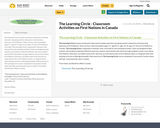
The Learning Circle has been produced to help meet Canadian educator's growing need for elementary-level learning exercises on First Nations. There are four classroom guides (ages 4-7, ages 8-11, ages 12-14, ages 14-16) on First Nations in Canada. The Learning Circle is organized in thematic units. each with its own teaching activities. Units are designed to give teachers and students simple but effective exercises, projects and activities that will encourage students to learn more about First Nations. Educators can follow some of the exercises as stand-alone units on First Nations topics, or integrate them with existing curricula on Aboriginal peoples. Most exercises in The Learning Circle can be completed in one period. Certain others will take several periods, days or weeks.
From Indian and Northern Affairs Canada.

The Legacy of Hope Foundation is a very comprehensive site that offers lots of great resources that help to promote healing and Reconciliation in Canada. The Legacy of Hope Foundation's (LHF) goal is to educate and raise awareness about the history and existing intergenerational impacts of the Residential School System (RSS) and subsequent Sixties Scoop (SS) on Indigenous (First Nations, Inuit, and Métis) Survivors, their descendants, and their communities to promote healing and Reconciliation.Check out each of the sections to see the great resources they have to offer.
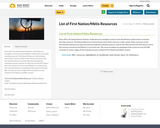
Since 2013, the Saskatchewan Teachers’ Federation has managed a contract from the Ministry of Education to evaluate learning resources. The Stewart Resources Centre houses most of the resources under review. These resources can be borrowed by patrons once they have been through the evaluation process. Look for the “Borrow from the STF Library” link in the resource records on the Ministry’s curriculum site. The resources below are samplings of the resources from the SRC currently at various stages of the evaluation process related to First Nation and Métis content.
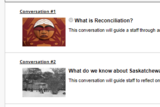
"The purpose of this support material is to assist educators in using collaborative inquiry to engage in conversations and develop actions to deepen their own, their students’ and communities’ understanding of residential school experiences and related issues that affect the process of reconciliation in Saskatchewan.
These materials may be used in a variety of contexts such as staff meetings, professional learning groups, workshops, school councils and community gatherings. The sample conversation questions and actions may also be useful for individual teacher reflection and planning."
Conversation 1 - What is Reconciliation
Conversation 2 - What do we know about SK residential schools?
Conversation 3 - How can we incorporate culturally-responsive practices in our classrooms to honour the Truth and Reconciliation recommendations and calls to action?
Conversation 4 - How can we move forward...?
Additional Supports
Other Projects in SK

Engaging lesson plans based on the Five Foundational Knowledge Themes. Educators have the opportunity to build their foundational knowledge while delivering Métis content through lessons that reflect promising practices.
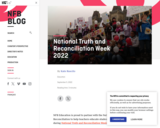
NFB Education is proud to partner with the National Centre for Truth and Reconciliation to help teachers educate students about Indigenous realities during National Truth and Reconciliation Week, as well as throughout the year.
This year, the theme of National Truth and Reconciliation Week is “Remembering the Children,” where we memorialize the children lost to the residential school system and honour Survivors and their families. The expanded program features age-appropriate material for students in Grades 1–12.
All sessions will be held virtually on Hubilo. Registration is required to stream live or pre-recorded sessions and to participate in the Q&A segment. The link for registration is provided on this page.

Reconciliation is about exploring the past and choosing to build a better future. Sharing stories of understanding helps one another to build trust. We want to hear about your moments of reconciliation.
Head to the "Education" Tab to access resources.

This Orange Shirt Day Activity Pack is ready to use in any intermediate (Gr.4-6) classroom to support important conversations around Orange Shirt Day. It includes:PowerPoint Fact files about Orange Shirt Day and Truth and ReconciliationResearch project templateArt activities and more!
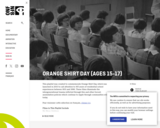
5 Films...
"Orange Shirt Day was launched in 2013 to call attention to 165 years of residential school experiences (1831-1996). For residential school survivor Phyllis Webstad, the severing of the threads connecting her to family, community, and culture began in 1973, when the beautiful orange shirt she wore to her first day of school was stripped from her and never seen again. The removal of the orange shirt was the first of a series of destructive methods enforced to deplete her sense of self-worth, erase her culture, and suppress her spirit. Her story is just one of the experiences described by countless survivors, but many others did not live to tell their own story. Intergenerational experiences rooted in the trauma inflicted through residential schools and other forced-assimilation policies continue to ripple through communities today...."

This resource, as the disclaimer says, is a continuing work in progress mapping out territories, languages and treaties. On this website you are able to click on an area and find out about related treaties and Indigenous languages. They have also developed a teacher’s guide.
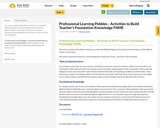
This resource guide and facilitator's book was created with Walking Together, Education for Reconciliation and The Alberta Teacher's Association.
The resource examines Awareness, Acknowledgement, Atonement, Action, and Truth in Reconciliation.
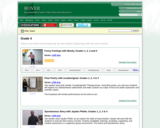
Check out these great video/curricular resources for Grade 4. The ROVER videos all indicate the curriculum outcomes that they address.
ROVER (Recommended Online Video Education Resources) is a video streaming service for Saskatchewan teachers and students in the PreK-12 education system. It is managed and maintained by the Saskatchewan Ministry of Education. ROVER is a video-on-demand service that provides teachers and students with the convenience of immediate access to streamed, educational videos that support curricula.
This site also offers all of the curriculum documents for all grade levels.
If you are unable to access the site, it may be because a Saskatchewan Ministry of Education Blackboard login is required. All students have an Edonline account, so contact your child's school or the Ministry of Education’s Support Desk at 1-866-933-8333 or email at stans@gov.sk.ca for login information. Your child's student number will be required.
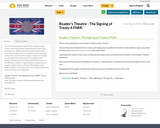
This is a lesson designed to teach Elementary students about Treaty 6.
The script has been divided into four scenes, each taking place at a different location. To help students make sense of the locations, here is an outline map of Canada with capital cities.
I have listed the readers in each scene to allow you the opportunity to include all class members in the Reader’s Theatre experience.
New words and locations are identified by an asterisk * to give teachers an opportunity to stop the reading to discuss the term.
Photographs of the people involved in the Treaty process are included at the end of the script.
Resource by Jade Ballek

This is a self-guided PD opportunity from the SK Ministry of Education.
Start by downloading and reviewing the PPT "Reconciliation and Treaty Education: Curricular Connections and Resources"
Then review some/all of the other opportunities including:
Introductory Module - Supporting the Journey Towards Reconciliation (also available here: https://resourcebank.ca/courses/supporting-the-journey-towards-reconciliation)
Module 1 - Starting the Conversation (also available here: https://resourcebank.ca/courses/module-1-starting-the-conversation-from-the-sk-ministry-of-education)
Module 2 - The Sixties Scoop (also available here: https://resourcebank.ca/courses/sixties-scoop)
Concentus Citizenship Education - Moving Toward Reconciliation (also available here: https://resourcebank.ca/courses/k-12-resources-for-citizenship-education-from-concentus)

Residential schools were boarding schools for Indigenous (First Nations, Inuit and Métis) children and youth, financed by the federal government but staffed and run by several Christian religious institutions. Children were separated from their families and communities, sometimes by force, and lived in and attended classes at the schools for most of the year. Often, the residential schools were located far from the students’ home communities. The schools were in existence for well over 100 years, and successive generations of children and families from the same communities endured this experience.
Understandably, the impacts were severe. This history was hidden for many years, until Survivors of the system were able to find the strength and courage to tell their stories. This lead to one of the largest class action lawsuits in Canada’s history. Though it will take time and commitment to heal the relationship between Indigenous Peoples and Canada, the reconciliation process has begun.